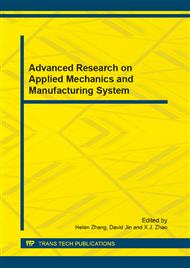p.89
p.93
p.98
p.102
p.107
p.111
p.116
p.120
p.125
Dimensional Synthesis of a Planar Parallel Mechanism for Wafer Transfer with Kinematics Performance
Abstract:
This paper deals with the dimensional synthesis of a planar parallel mechanism for wafer transfer with kinematics performance. Under the relationship between workspace and parametric, a kinematics performance index, which is composed of the conditioning number of the Jacobian matrix and the motion resolution, is considered as the evaluation criterion. And a new index which is proposed by considering both the mean value and fluctuation of the pre-mentioned index is used to optimally design the dimensional parameters. It is testified that the optimal dimensional parameters can satisfied with the kinematics performance.
Info:
Periodical:
Pages:
107-110
Citation:
Online since:
December 2012
Authors:
Price:
Сopyright:
© 2013 Trans Tech Publications Ltd. All Rights Reserved
Share:
Citation:


